16 Tips For Making The Ultimate Deep-Dish Pizza
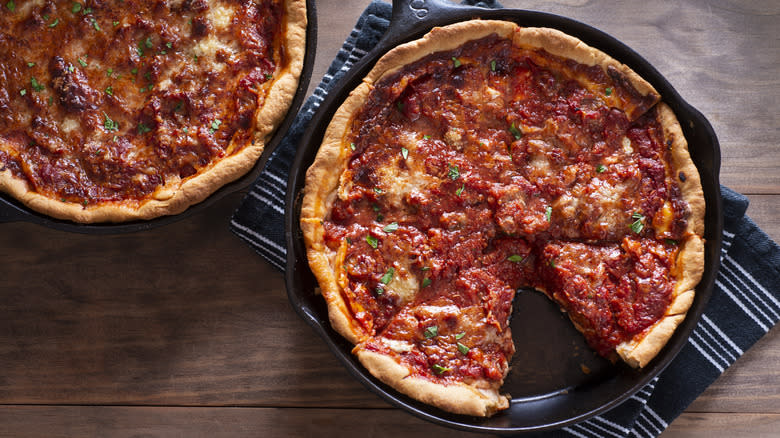
You'd be hard-pressed to find a type of pizza as divisive as deep-dish. This monstrosity of a pizza, which differs in both texture and consistency from the dainty apizza and Neapolitan slices found in other parts of the country, is deeply embedded in the history of Chicago. The first pizza of this kind was believed to have emerged in the 1940s at Pizzeria Uno, where owners Ike Sewell and Ric Riccardo sought to make a pizza that could unite the Italian immigrant community in the Near North Side of Chicago. Besides this origin story, Chicago-style deep-dish pizza is so unique because it's made in a round pan, which is often either a cast iron skillet or a cake pan, stacked with mozzarella cheese, fillings like sausage, and a thick layer of tomato sauce on top. And in case you were wondering, it's always eaten with a fork and knife.
Although this type of pizza might look intimidating, the fact that you don't have to stretch out the dough thinly, rotate it in the oven constantly, and blister the edges makes it a relatively low-maintenance pie to master at home — relative to other regional pizza styles. We've collected the best advice for making the iconic Chicago deep-dish at home and bringing a taste of the Windy City into your kitchen.
Read more: 12 Pizza Styles From Across The US, Explained
Always Pre-Heat Your Oven Before You Bake

One of the biggest mistakes people make when baking not just deep dish pizza but also cookies, cakes, and brownies, is not adequately preheating the oven before they start cooking. Preheating is such an important kitchen step when working with raw meats (like sausage) because it will ensure the food is cooked to its proper internal temperature, which reduces the risk of contracting a foodborne illness.
Preheating is especially important for pizza because the dough contains yeast. Popping the pizza into a hot oven ensures that you get the right amount of doughy puff on your pie rather than a scorched and overbaked texture. The exact time it takes to preheat your oven will depend on the appliance itself. To be safe, aim to preheat the oven for at least 10 minutes before checking the temperature with an internal reader since dials tend not to be as accurate as you'd think.
Measure Your Crust Ingredients Precisely
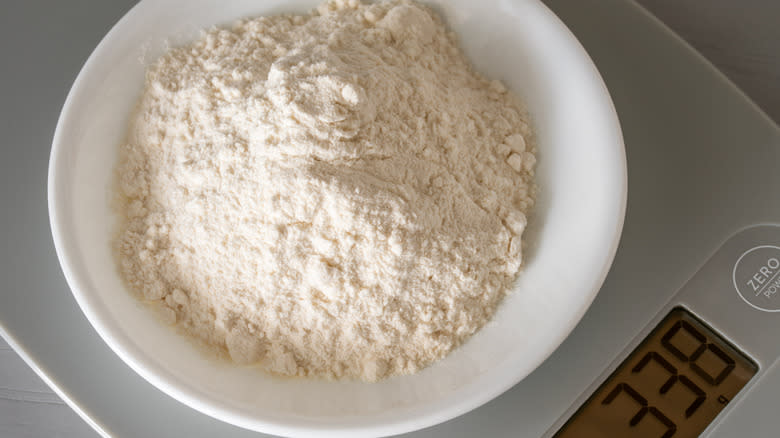
Making any type of bread (which includes pizza dough) is both an art and a meticulous science. If your crust isn't coming out with the ideal texture, you likely improperly measured your ingredients or didn't follow the preparation instructions to a tee. A good crust recipe will include clear instructions measured in weight rather than cups, teaspoons, and tablespoons. This will ensure you get the most accurate dough every time because someone's "one cup" can vary from someone else's.
To ensure your dough gets the proper rise in the oven, you should also be sure to check your yeast for freshness before adding it to your recipe. You can do this by mixing a small portion of the yeast with water and sugar (no other sweetener) in a glass and waiting for bubbles. You'll also want to follow your recipe's specific instructions for what type of yeast to use (instant versus active dry) and the recommended water temperature to add to the dough. If the water is too hot, you'll kill the yeast, but if it's too cold, you won't get enough rise.
Cook With A Crust Recipe Specific To Deep-Dish Pizza

If you're making deep-dish pizza for the first time, you might be inclined to pick out any old pizza dough recipe from the internet or pick up a bag of dough from your local grocery store. However, failing to select a recipe specific to making deep-dish pizza will result in problems later on in the baking process.
The ideal hydration ratio for a deep-dish pizza is around 70% to 80%. The hydration ratio refers to the amount of water added relative to its flour content. For example, a deep-dish pizza requiring 1,000 grams of water needs between 700 and 800 grams of flour. This ensures that the crust's texture is significantly breadier than a Neapolitan or a New Haven apizza style. Because deep-dish pizza crusts tend to be wet, they can be sticky and difficult to shape for novice breadmakers. Be sure to use a lot of flour when handling the dough to prevent stickiness.
Don't Rush The Rise On Your Dough
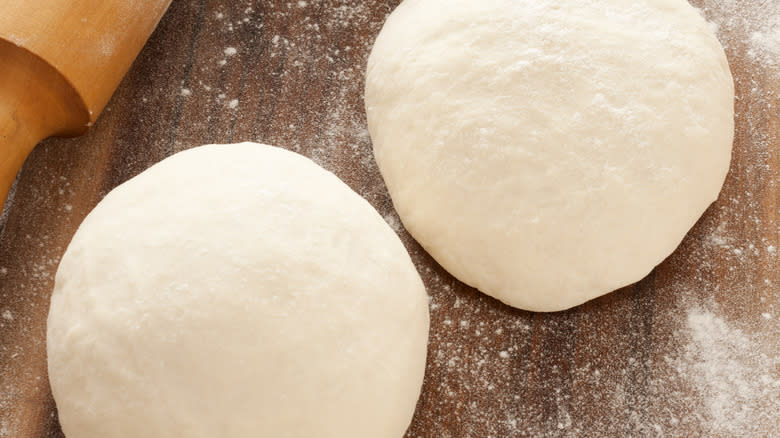
If you want to get dinner on the table fast, we recommend ordering a deep-dish pizza instead of making it yourself. To ensure you get a proper rise on your deep-dish pizza crust, you'll need to let it rise and proof before shaping it into your dish. The entire process can take up to a few hours.
There are many reasons why your pizza dough might not be rising to its fullest potential. To help speed up the rising, you can also pre-heat your oven on low, shut off the heat, and then stick your bowl into the oven to give the dough a warm space to work its magic. Besides rushing, which doesn't give the yeast enough time to eat the simple sugars in the dough and produce the carbon dioxide that gives it a bubbly lift, you may not have mixed the dough together enough, which leads to the gluten in the flour not forming as many intricate networks to trap the carbon dioxide bubbles.
Use The Correct Type Of Pan For Baking The Pie
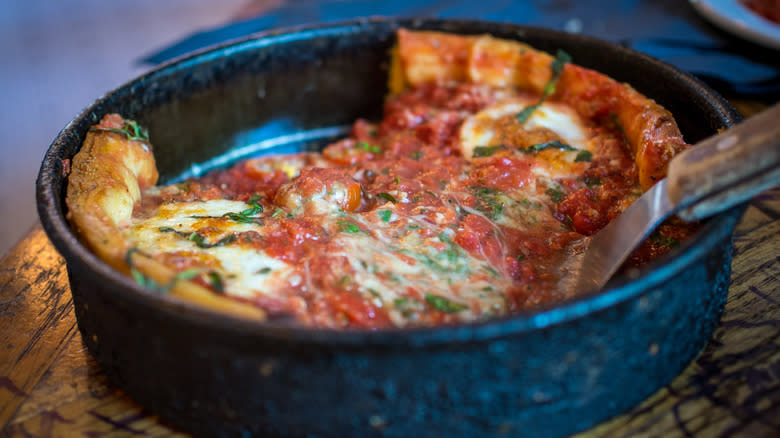
Mastering a deep-dish pizza means picking the right pan for the job. Traditionally, deep-dish pizza was made with a cast-iron skillet. These skillets, although heavy, tend to have high sides perfect for piling in your favorite toppings. The iron also conducts heat remarkably well, which is perfect for getting the perfect golden brown hue on the sides of your crust. If you opt to work with a cast-iron pan for your pizza, we recommend seasoning it well with oil to ensure the crust gets perfectly crispy, and you can easily lift it from the pan when you're ready to serve it.
Other folks will go for a hard anodized aluminum pan for baking their deep-dish pie. You can also opt for a carbon steel baking pan, which is slightly more expensive but more resistant to warping and has better heat retention than a cheaper aluminum pan. If you're a novice baker, you might also choose a springform pan, which has a locking mechanism on the side for easy removal.
Aim For A Thick, Rather Than Thin, Sauce
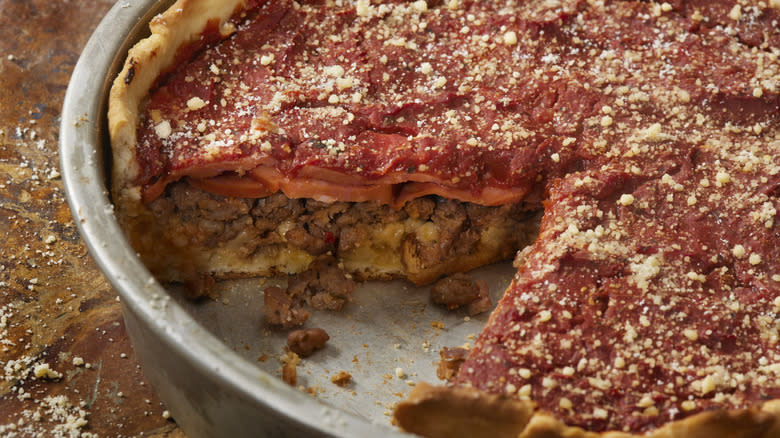
An important distinguishing factor between deep-dish pizza and thinner pizza styles is that the former is made with a thicker, sweeter sauce. The unique texture and taste of this sauce come partly because it is placed on top of the pie before it's baked rather than sitting beneath shielding layers of cheese and toppings. This layering evaporates some of the moisture and concentrates the slightly caramelized tomato flavor.
The key to making the perfect deep-dish tomato sauce is adding butter. This ingredient accentuates the flavor of the tomato sauce and complements the thick crust well. You should also consider adding aromatics, like garlic, finely grated onion, and herbs such as oregano and red pepper flakes to give your sauce a remarkable flavor and aroma. You'll also want to simmer and reduce the sauce on the stove before spooning it onto the top of your pizza since this will further thicken it.
Coat Your Pan In Lots Of Oil
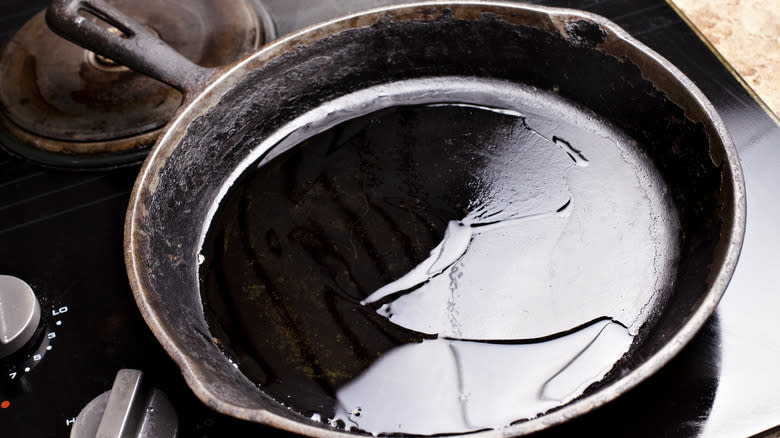
Oil is a key, often-forgotten ingredient for making deep-dish pizza. Traditionally, corn oil is added to the pizza dough to keep it moist and pliable, and it was believed to be a nod to the city of Chicago and Illinois as a whole — one of the great corn-producing states of the nation. In addition, adding oil to the dough helps keep the gluten strands short, which creates a tender bite rather than an elasticky and snappy one. You should plan to add as much as three tablespoons of oil for each cup of flour to ensure your dough stays supple.
You'll also want to use a plentiful amount of oil in your skillet or baking pan before you place your dough in. Not only will this layer of oil buffer from any sticking, but it will also result in a crisp crust on the sides and bottom and delectably soft in the middle. You may need upwards of four tablespoons of oil to ensure that all the sides and bottom of your pan are sufficiently coated, but the resulting pie will be well worth it.
Par-Bake Your Pie Crust To Give It A Head Start
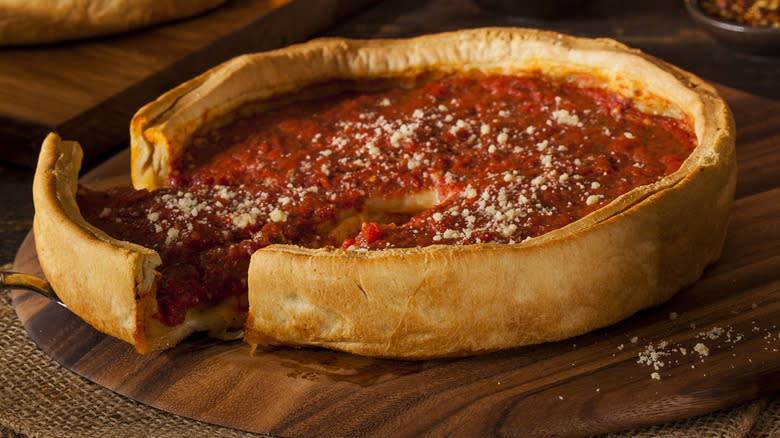
Should you par-bake the pie crust before making a deep-dish pizza? Many people choose not to pre-bake their pizza crust before piling in their toppings, but others will argue that it gives the crust a little bit of an extra push to brown and harden before the notoriously wet toppings are piled in. After all, we don't want any soggy bottoms here!
If you plan on par-baking your crust, you'll only need to bake it for about 10 minutes before pulling it out and adding your toppings. Once your toppings are added, you can return the pie to the oven and bake until your toppings are oozy and your crust is golden brown. And if you find your crust is browning faster than the toppings can set, you can add an aluminum foil tent to the top of your pan for the last 10 minutes or so of cooking.
Don't Skimp On The Cheese
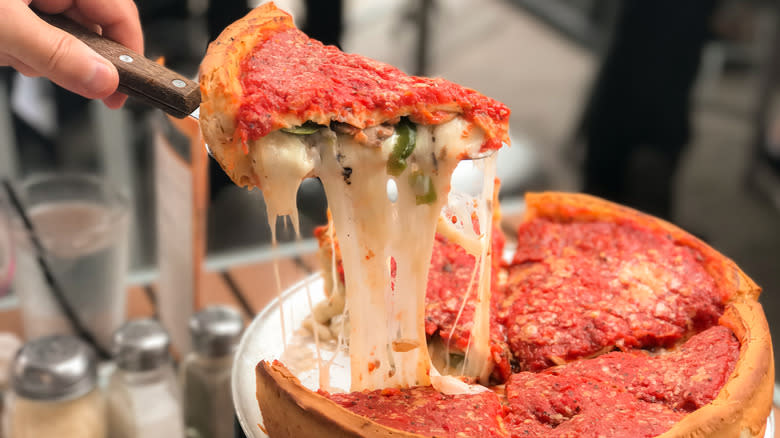
Cheese can make or break your deep-dish pizza. Now is not the time to be stingy about your cheese, nor is it the time to deviate from the tried-and-true types of cheese used for a deep-dish pizza recipe. Sliced mozzarella, not shredded, is integral to deep-dish pizza. You'll likely need to go to the deli section of your grocery store for this unconventional ingredient and always choose a low-moisture variety to prevent making your pizza too soggy. When it comes to adding it to the bottom of your pizza, use enough cheese slices to achieve the perfect, Instagram-worthy cheese pull.
Deep-dish pizza also features grated Parmesan on top. This umami-rich cheese should always be freshly grated rather than the pre-grated (or even worse, shelf-stable) stuff you find at the grocery store. When combined with a drizzle of olive oil, you'll find that the flavor is absolutely sublime and worthy of as much credit as the mozzarella.
Methodically Layer Your Ingredients In The Pie
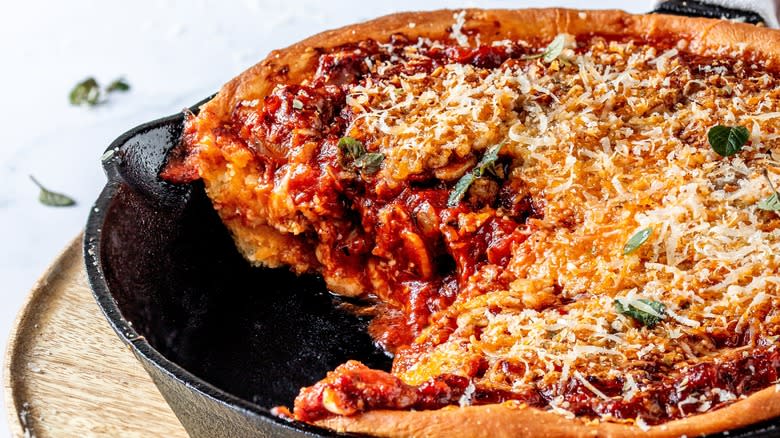
Deep-dish pizza can be a bit strange for first-time eaters because it is essentially a pizza that has been inverted. Instead of layering on the crust, sauce, cheese, and toppings, the traditional Chicago deep-dish features a layer of sliced mozzarella, the toppings, and then the sauce on top. Is it weird? Yes. But there is a reason why these layers all make sense.
The mozzarella slices must be layers on the bottom of the pie because it will protect the juices and sauce from the upper layers from dripping down and making the bottom of the pie soggy. Fan these slices out to the edges, even allowing some of the cheese to overlap the sides of the crust. Once you've adequately covered the bottom of your pizza with the cheese slices, then you can layer in your meat. Sausage, both sweet Italian and spicy, is common, and most recipes suggest that you leave these raw because the pie is in the oven for long enough to cook the meat sufficiently. Then, add your sauce, grated Parmesan, and you're good to bake.
Cook Your Deep Dish Pie In The Center Of Your Oven
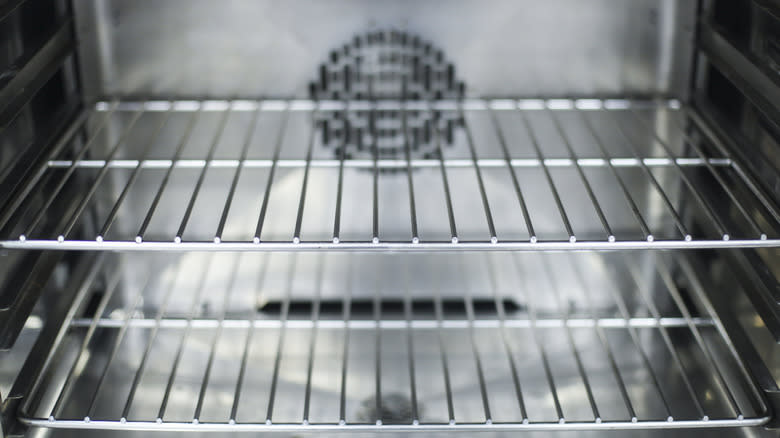
You're going to need to be methodical about where you place your pizza in the oven to ensure it bakes appropriately. When it comes to baking almost anything, the best placement in your oven is in the center rack. Most conventional ovens have heating units on both the top and bottom, so placing your pizza right smack in the middle ensures that the top will brown while the bottom will evenly cook. To counteract any oven hotspots, you should also rotate your pizza about halfway through the baking time. Taking a peek into your oven every 20 minutes or so will ensure that your pie is evenly browned on all sides. If you're baking several trays of deep-dish pizza, you may want to swap the trays halfway through the baking time to ensure both bake evenly.
It's notoriously difficult to tell when a deep-dish pizza is done baking because of how bubbly the sauce is. When in doubt, stick a kitchen thermometer into the pizza's center so it's poking the bottom crust. The temperature should register at least 190 F.
Bake Hot, Or Try An Outdoor Pizza Oven
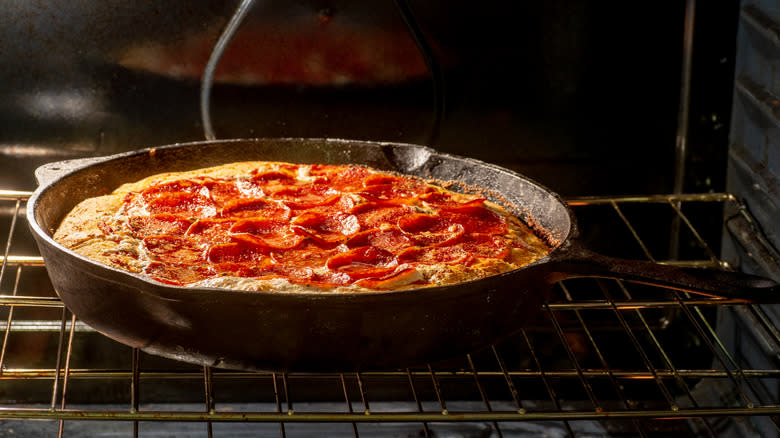
Deep-dish pizza will never bake as fast as a thin-crust pizza. This is because the ovens that these thin, blistered crust pies are baked in can get up to 1,000 F. The cooking zaps out the moisture and cooks the toppings just enough so everything melts and melds together. On the other hand, deep-dish pies need more time and less heat to develop their signature flavor and consistency.
Chicago-style deep-dish pies vary in temperatures between 375 F and 500 F. If your pie has a heavy topping load, it will need more time or a hotter temperature to ensure that all of the components are sufficiently cooked through. You can also expedite the cooking process by cooking the base of your pan on a pizza stone. This stoneware piece must be heated in the oven alone at around 500 F for 30 minutes to bring it to the proper temperature. After you turn the heat down, place the pan on the stone and watch as your pizza bottom crisps up perfectly.
Let Your Pizza Set Before You Cut Into It
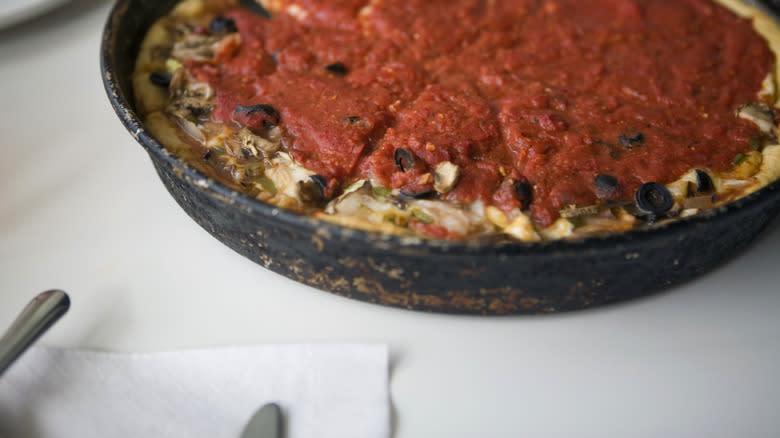
The last thing you'll want to do when you take your deep-dish pizza out of the oven is to let it sit. However, this buffer time is necessary if you want to avoid the dreaded ooze when you slice into it. And since you've worked so hard for a perfectly cooked pie, why would you ever give up now?
At a minimum, you should allow at least five minutes for your pizza toppings to set. However, giving your pizza a little over 10 minutes is preferred, especially if you're working with a pizza with many wet layers. To help speed up the setting process, elevate the bottom of your pie on a wire rack to allow the air to circulate underneath it. In the meantime, you can clean up your kitchen or pour yourself a glass of wine. You deserve it.
Use A Knife Instead Of A Rolling Cutter
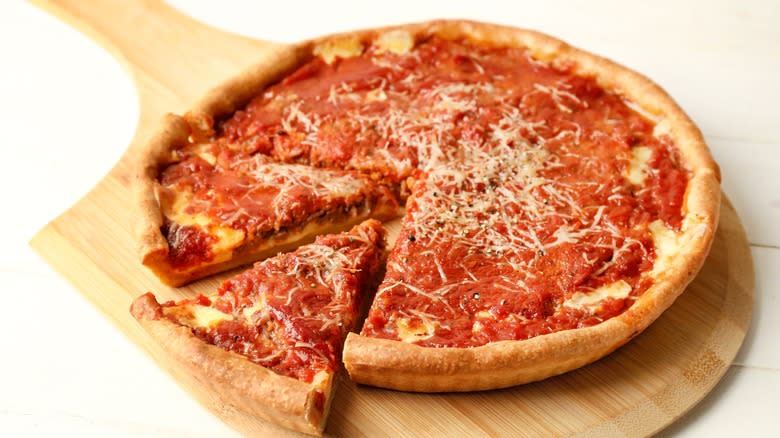
How do you even slice a deep-dish pizza? If you're standing next to it with your standard pizza roller, you might be a little bit overwhelmed. The best tool to cut your deep-dish pizza isn't that rolling cutter; it's a rocking pizza blade cutter. Not only can you use this blade cutter to slice through dense, deep-dish pizza with ease, but you can also use it to cut perfectly square brownies or Neapolitan slices, too. We especially love that this blade won't push off your toppings like a standard roller, and you can pop it in the dishwasher when you're ready to clean it.
The other (messier) option for cutting your pizza is pizza shears. You can even get these scissors outfitted with a server attachment for easier use. Just be prepared to get a little saucy when you're trying to slice your way through your deep-dish creation.
Play With Unique Deep Dish Variations
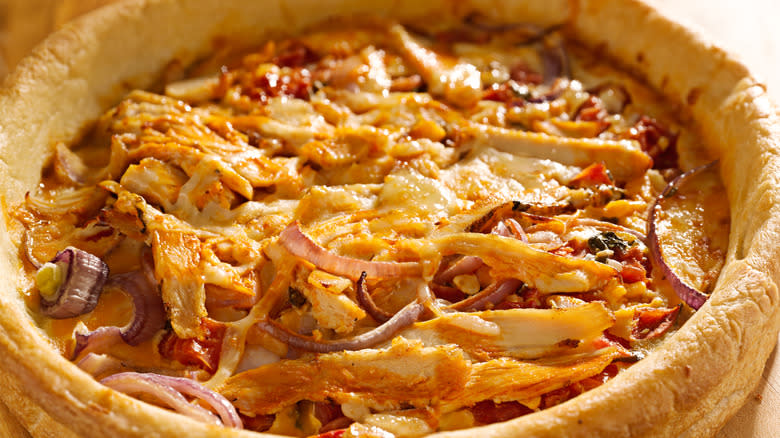
Deep-dish pizza doesn't have to fit the mold of cheese, sausage, and sauce. You have a lot of creative license in making the pizza however your heart desires. If you're a big fan of buffalo chicken, add it as a filling with red onions and bacon. Add a layer of cheese on the bottom of the pie and coat the top with extra buffalo sauce instead of the standard tomato sauce. Serve each slice with a drizzle of ranch dressing and chopped chives, and we guarantee that you'll be the talk of your next tailgate party.
One of the most common renditions of Chicago's famous pie is the Detroit-style deep-dish pizza. It is technically a deep-dish pie because it has high edges and is cooked in a heavy-gauge pan. However, these rectangular pies have several major differences. The focaccia-like Detroit-style dough is topped with rows of pepperoni and cheese (often mozzarella, provolone, or Wisconsin brick). , The cooked sauce is reserved and instead added to the pie after serving, rather than being poured on top of the pie before it is put in the oven. It's essentially glorified cheesy bread with a bit of caramelized crispy goodness.
Use A Muffin Tin For Tiny Deep Dish Pizzas
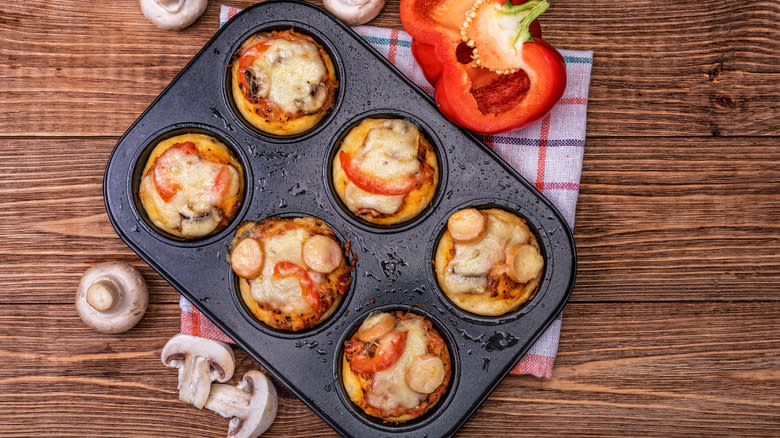
One of the downsides of making a deep-dish pizza is that you have to justify making a whole large pizza for yourself. But, if you have a spare muffin tin or hamburger bun pan lying around, you can have mini deep-dish pizzas perfect for satisfying a pizza craving. If you're using a hamburger bun pan, which is shallower and wider than a muffin tin, you'll need about 2½ ounces of dough for each well. Fill the pan similarly to how you would normally make a deep-dish pizza, par-bake for 10 minutes, and bake at the same recommended time and temperature as your aluminum or cast iron pan.
Like making standard deep-dish pizza, it's important to adequately coat the sides of your pan with cooking spray to ensure no dough sticks. You should also take an internal temperature of the pie to ensure that it is not overbaked, as baking in a small vessel tends to speed up this process.
Read the original article on Tasting Table.

